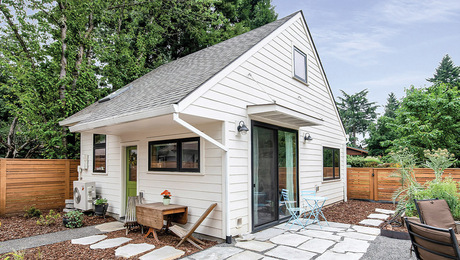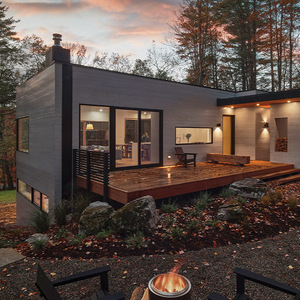*
I would appreciate it if someone could run through a shared well system for me. I grew up on well water so I know how a well system works for one house, but I will soon be building my house on a lot that already has a well on it. Only one house uses it and I plan on using a shared system as other houses in the area do. I would like to know the pitfalls(besides running out of water,burning through pumps,and fights with my neighbor).I would also like to know about the mechanicals of that type of system.Thanks for any input.
Discussion Forum
Discussion Forum
Up Next
Video Shorts
Featured Story

Key proposals for the next edition of the International Residential Code tackle room sizes, stair specs, emergency egress, and deck guards, among other requirements.
Featured Video
Builder’s Advocate: An Interview With ViewrailHighlights
"I have learned so much thanks to the searchable articles on the FHB website. I can confidently say that I expect to be a life-long subscriber." - M.K.
Fine Homebuilding Magazine
- Home Group
- Antique Trader
- Arts & Crafts Homes
- Bank Note Reporter
- Cabin Life
- Cuisine at Home
- Fine Gardening
- Fine Woodworking
- Green Building Advisor
- Garden Gate
- Horticulture
- Keep Craft Alive
- Log Home Living
- Military Trader/Vehicles
- Numismatic News
- Numismaster
- Old Cars Weekly
- Old House Journal
- Period Homes
- Popular Woodworking
- Script
- ShopNotes
- Sports Collectors Digest
- Threads
- Timber Home Living
- Traditional Building
- Woodsmith
- World Coin News
- Writer's Digest


















Replies
*
While you wait for someone to answer your questions, you might see where this link leads you:
http://www.hud.gov/offices/hsg/sfh/ref/sfh1-21c.cfm
In our community, there is a Water Master who can answer such questions. I would guess that many specifics vary from state to state. In our state, the Water Master is at the county level. (In Oregon, you need a water permit to water more than half an acre from a well, among other things.)
*To add to Casey's caveats, if you add enough homes to a system, you start bumping into EPA and state requirements for initial testing, monitoring, etc. Which would be thousands a year in analytical lab fees and reporting requirements. Not sure where the cut-off is, but would guess it is at least 5 homes.As to your question: Of course the well needs to have a higher yield than for a single-home well. The flow rate doesn't need to quite twice (well yield and pump size) if you can avoid watering your lawns at the same time. Holding tank ought to twice the size or use two in parallel. Site the holding tank in the higher elevation house with a typical pressure switch setting (30-50 or 40-60 psi on-off). If the lower house is more than 40' lower, put a pressure reducing valve between the houses.Consider the small added cost of larger or more numerous holding tanks. The greater above-ground capacity you have, the fewer starts and stops the submersible pump will make. And the longer it will last. Also, you will be more immune from short-term shortages of water (e.g. toilets and showers running in both houses). Your ability to run lots of garden sprinklers will remain limited by the well and the pump capacities.Broadly, this is a good approach. Why should every house drill a well when a lot of wells produce more than enough water.If you both have plenty of money in the bank, great. If not, maybe you should set up a joint-owned, joint-signature account for well-maintenance. Both parties put in $5/month. A decade from now, when the pump needs replacement, you've got the money in the bank. -David
*Here in California, the maximum number of houses you can have on a water system before it bumps into regulation is four. There is another bump up when it hits 25. David has a good idea on what you need to set up for maintenance. We have it set up for $10 a month above the electricty rate until the joint account reaches $2500. That amount would take care of most repairs and upgrades. Plenty of unpressurized storage is reccomended, for those times when the well pump is being replaced, power outages, etc. We run 15000 gallons for four parcels, in the desert. Lasts about a week with no input.Erich
*Thanks for the responses guys. I like the idea of a joint account. The well already has its own electric service so the concept of splitting that bill and adding five bucks each a month into a joint account to cover repair or maintenance costs sounds great. It would add a comfort zone. Another question I have is this. The well that exists has its own meter at the well head. My neighbors house that uses it is a good 100 feet away. When I build my house I plan to put a duel meter service in so that we can split the bill. How would the system work? Would the pipe from the pump have its own pressure switch and tee off towards the two houses? Would each house then have its own pressure tank with pressure switches connected to solenoid valves between the tank and the water pump line? Hence the main pressure switch would maintain pressure on the main line. Then when pressure fell bellow the cut in point on either of the individual houses pressure switches the valves would open and pressurize the tanks. Is this system I describe way off the mark? There will only be the two house connected to the well. I would definitely opt for the largest tank I could fit in the mechanical area to minimize short cycling of the pump. It would also allow me to have water in case of short power outages.
*Woah. Back up. Think of a normal house with two bathrooms. Now think of each of your houses as one of those bathrooms. You don't dupicate the well, pump, service piping, pressure switch, etc. You perhaps upsize the pipes and the storage tank.Having each house call for water seperatly is a needlessly complication. Draw water from both houses off of the same holding tank(s). When the holding tank needs more water, the pressure switch will activate the pump. That holding tank(s) could be in either (or in mild climates, at the wellhead.).Rather than two electical meters (which introduces huge complications - it can be done, I could do it, but I never would); use two water meters. I've bought 5/8" totalizing flow meters (with big spinning needle and a little odometer on it) for $53 each. Then pro-rate the single electric bill. Better yet, don't sweat it. There'll be weeks when you water your lawn a lot. Other weekends, his teenager will live in the shower. I'd accept any minor inequities for the simplicity of splitting the bill 50/50. -David
*The way we do the well is that each house has its own pressure system. The services to each parcel is unpressurized. Jet type pumps work well with the low head from the unpressurized storage tank. The unpressurized storage tank refills itself as necessary. Prorating the electric bill is easy if each service is metered. Just set up a little Excel spread sheet to figure it out from the meter readings and bill.Erich
*When you are thinking of a shared well go well beyond the mechanics and the bean counting. That is the least of what you need to consider.Consider how things are going to be in a couple of years when the nice family next door sells to the family from hell. Or, the other family goes broke and can't pay their part of the expenses. Then the well needs some work on it. You had better be ready legally, financially and most of all emotionally to cope with this.Farfetched? Well I know of more than one situation exactly like this.So, shared wells can save money, especially in areas where well drilling costs are very high. But they also bring with them liabilities that can more than offset any savings, especially if the neighbors don't want to cooperate.So, think this through carefully before you do the deed. The best situations I have found is when the homeowners set the well up as a Utility. This isn't very practical for just two or three houses. But from your post I suspect there are several houses and lots involved. Check with the local Water Gurus. They will be able to help you with the details.
*Erich: Are you describing a system with a jet pump in each house? Or a single jet pump feeding separate unpressurized tanks? With a jet pump in each house, you certainly reduce the shared components down to only the well itself. I agree that is an option. I always go for submersible pumps when I can for their greater efficiency (a lot of my installations pump 24/7.) Therefore I lean towards a single pump (down the hole) which therefore makes a single (or gourped set of) holding tank vastly easier to install.That said, having separate, above-ground jet pumps would reduce the possible conflicts that FredB mentions. -David
.......then the board changed and there wern't anymore responses.......
Well, I'm still out here in cyber-constructionland. Did you have any more questions?
David Thomas Overlooking Cook Inlet in Kenai, Alaska
This is the first I've seen this thread. We are developing some properties and this very issue came up. Here in Thurston County, WA, if you have more than two parcels sharing a well it has to be turned over to a third party to operate. But even having only two parties share a well changes the building free radius around the well. I would check with your local building department before I got too carried away planning a shared well.
And I agree that this is prime ground for petty hostillities between neighbors. I think it was David Frost who said "good walls make good neighbors". Even if you know YOU can rise above that stuff, there's no telling who will move into the neighboring house if the present owners leave. Another thing, that set up would almost HAVE to make your place a little less sellable, if you are thinking along those lines.